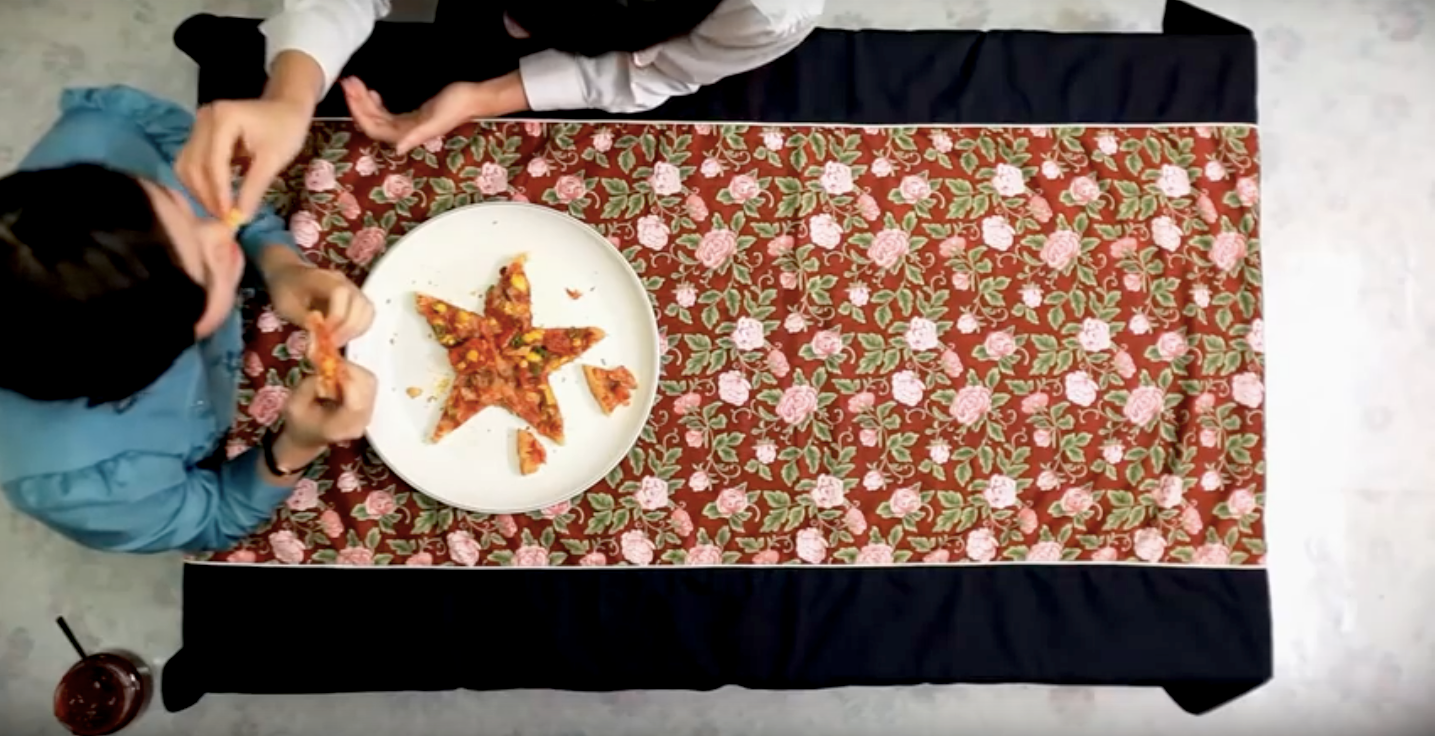The Politics of Smuggling Pizza-Making Videos Into North Korea
Pyongyang has a pizza scene, but only for the upper crust.

Hwang Kim, a South Korean artist, recently made headlines for smuggling unusual contraband across the border to North Korea: home-cooking videos. They are part of a series of short films Kim directed, dubbed “Pizzas for the People,” that he burned onto 500 DVDs. His culinary espionage wasn’t for kicks, though. It was a sly act of resistance intended, in his words, to “subtly [challenge] an ideological status quo.”
“Pizzas for the People” is a cooking show-cum-fake documentary series that follows several South Korean actors. “The film is intended to be a highly stylised satire of NK, where you need to be part of the political élite to eat pizza,” he writes. But Kim’s films also ask the audience to imagine the unthinkable: “What if North Korea became democratic? What mechanisms will be at play in this transformation?” And, “What will North Koreans do with their newfound freedom?”
His answer includes making pizza together. In the first film, the young protagonist shows viewers how to hack a pizza at home by using a whiskey bottle as a roller. In it, she criticizes the exclusive nature of pizza restaurants in Pyongyang, which has seen several Italian-inspired eateries open in recent years, despite years of ongoing food shortages and undernourishment. “It is so hard to get the chance to eat there,” she says. “It’s like asking for the moon and stars.”
Kim made the films in response to the highly-publicized opening of a Pyongyang pizzeria in 2009. “In North Korea, there is very limited access to influences from other cultures, for ordinary people, at least,” Kim told Deutsche-Welle. “The political leadership has these privileges, of course. And suddenly there was a pizzeria in North Korea. But very few people could actually eat there.”
At around $5-10 each, pizza is still astronomically expensive for many locals. (In 2016, North Korea’s per capita gross national income was estimated to be around 1.5 million won, or $1,342 a year.) So only a small elite in the North Korean capital, as well as diplomats and wealthy foreigners, can afford to enjoy the growing pizza scene.
But that’s not the story told by North Korean-adjacent media. Ri Bong Nyo, a server at one Italian joint, told NK News that everyone could enjoy the pies, and that they were so popular that street vendors are now hawking Italian fare, too. “General Kim Jong-il said that the people should also be allowed access to the world’s famous dishes,” Kim Sang-Soon, a manager for the restaurant, told Choson Sinbo, the Tokyo-based newspaper that’s said to be chummy with the regime.
The Hermit Kingdom isn’t exactly known for embracing outside influences. But as Munchies notes, the rise of a middle class in the past 10 years (it’s small, but very well-off compared to the average North Korean family) has propelled the expansion of non-Korean restaurants. This includes a western-style coffee shop, popular sushi bars, and a burger restaurant. But in a city with only a handful of visitable restaurants, it’s Pyongyang’s handful of Italian places that stand out. In fact, in 2016, there were more Italian restaurants in Pyongyang than Chinese restaurants.

The first of these establishments to serve pizza, the Pyolmuri Café, was a European-inspired establishment. Run by the Adventist Development and Relief Agency, its profits funded local relief work. But like many North Korean developments, the country’s burgeoning Italian scene was largely due to its dictator’s whim. That’s especially true in the the case of the aptly-named Pizza Restaurant, which opened in 2009. A decade or so in the making, it fulfilled Kim Jong-il’s longtime dream to open a pizzeria in North Korea. Back in the 1990s, he flew in a team of Italian chefs to teach local cooks how to make pizza (down to the spacing between olives). Jong-il shuttled chefs to Naples and Rome to accrue pizza-making secrets, reportedly had stone pizza ovens flown in, and eventually opened the pizzeria.
A more recent addition, Italy Pizzeria, opened its doors in 2016. North Korean chefs sling pies in an extravagant-looking space, chandeliers and all. Some tourists and guides have said that while the pizza in Pyongyang isn’t exactly authentic, it’s decent enough, with a few twists. The chefs don’t throw the dough, and they cover pies with less cheese in lieu of toppings such as kimchi and fruit—something we also see in one of Kim’s videos, where the dough is likened to “a western pancake.” Other reviewers struggled with the slices because, among other issues, the dough was “soft and flavorless, and lacked any bite.”
But for many North Koreans, pizza is something they seldom get to see or try. That’s what makes Kim’s smuggled videos especially impactful. By imagining the country as a place where anything is possible, the films invite North Koreans to explore food on their own terms—and to question why mostly politicians and military leaders get to enjoy Pyongyang’s pizzerias. It helps that distributing the videos on the black market, as Kim did, apparently isn’t that tough to do. “It’s an open secret that cross-border smuggling is thriving,” Kim said. “Goods and money are always getting into the country that way. Officially, of course, it’s banned, but the North Korean government turns a blind eye because it’s good for its economy.”

Kim has said that the smugglers eventually brought back fan mail from people who had seen the videos in North Korea. Upon returning, they told Kim that they quickly found takers for the videos. Due to the country’s isolation and censorship, and going just on reports from the smugglers, it’s tough to know whether Kim’s pointed message resonated among many North Koreans. But just the fact that some people included photos of themselves with their homemade pies is a strong testament to the power of pizza—especially when it’s in the hands of the people.
Gastro Obscura covers the world’s most wondrous food and drink.
Sign up for our email, delivered twice a week.

























Follow us on Twitter to get the latest on the world's hidden wonders.
Like us on Facebook to get the latest on the world's hidden wonders.
Follow us on Twitter Like us on Facebook